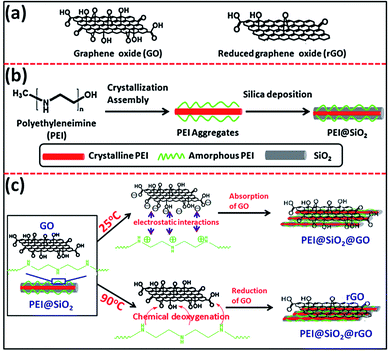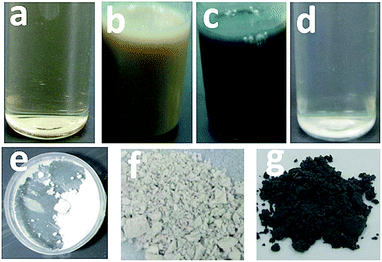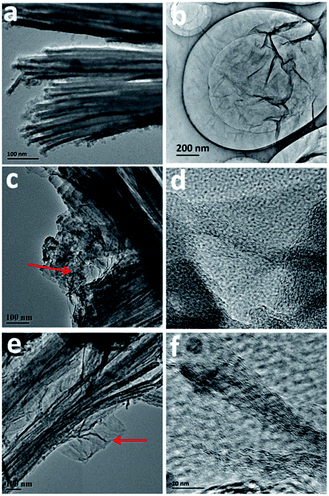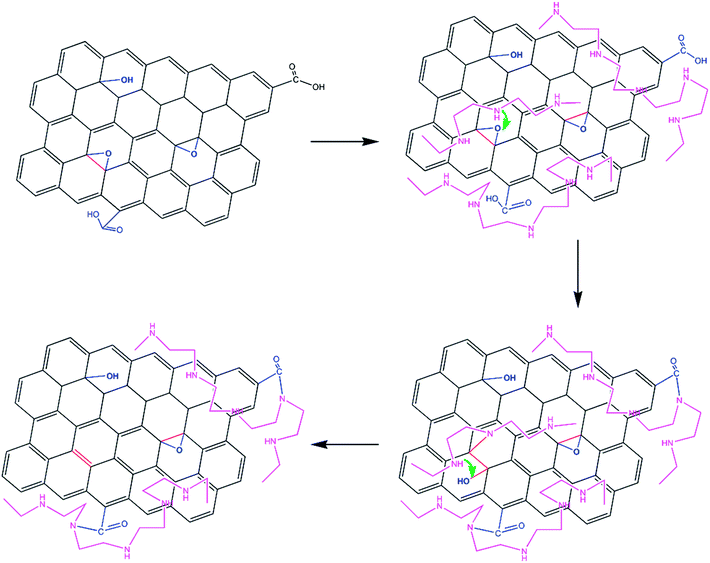Synergistically constructed polyamine/nanosilica/graphene composites: preparation, features and removal of Hg2+ and dyes from contaminated water†
Xinling Liuab,
Yanfeng Gao*ab,
Hongjie Luob and
Renhua Jinc
aSchool of Materials Science and Engineering, Shanghai University, 99 Shangda Road, Shanghai 200444, China. E-mail: yfgao@shu.edu.cn; Fax: +86-21-6990-6218; Tel: +86-21-6990-6218
bShanghai Institute of Ceramics, Chinese Academy of Sciences, 1295 Dingxi Road, Shanghai 200050, China
cDepartment of Material and Life Chemistry, Faculty of Engineering, Kanagawa University, 3-2-7 Rokkakubashi, Yokohama 221-8686, Japan
First published on 28th January 2014
Abstract
A simple method was developed to construct graphene–nanosilica composites. Polyethyleneimine (PEI), which is a synthetic polyamine functionally analogous to bio-polyamines in organisms, was used as a template/scaffold/catalyst to direct nanostructured silica formation, i.e., PEI hybridised silica (PEI@SiO2). Due to the cationic nature and reducibility of PEI, the hybrid PEI@SiO2 surface instantly adsorbs the negatively charged graphene oxide (GO) at room temperature, leading to PEI@SiO2@GO composites. The GO was further reduced in situ into reduced grapheme oxide (rGO) to form PEI@SiO2@rGO at 90 °C. The PEI@SiO2@GO showed a high removal efficiency of 96% for Hg2+ from a 10 ppm solution; PEI@SiO2@rGO could decolorise organic dyes (rhodamine B or methyl blue) from solution after 30 min. Unlike previously published methods for producing graphene–inorganic composites, this method is general to other polyamine–silica (or metal oxide) systems and has the synergistic efficiency to target GO without additional surface modification and reductants.
Introduction
Graphene, a star material containing a monolayer of carbon atoms arranged in a honeycomb network, has sparked much research interest in the last few years due to its unique structure and remarkable mechanical, electronic, optical, and thermal properties.1–3 Graphene oxide (GO), a water-soluble graphene derivative, shows a similar two-dimensional structure but possesses many more oxygen-containing groups (e.g., carboxyl, epoxy, hydroxyl) (Fig. 1a). One feature of graphene oxide (GO) is that it can be (partly) reduced into graphene-like sheets by removing the oxygen functionalities, thus resulting in reduced GO (rGO) (Fig. 1a).4–6 To harness the superior properties of GO and/or rGO, one proposed approach is to incorporate them into composites to achieve collective and/or synergetic properties of the multiple components. For example, a series of components (e.g., SiO2, TiO2, ZnO, Fe3O4, CdS, Si, C60, polymers) has been successfully used and incorporated with GO/rGO to construct functional composites with diverse applications in catalysis, energy conversion, sensors, pollutant removal and biotechnology.7–11To fabricate GO/rGO–inorganic component composites, two general methods can be employed. One is the in situ growth of inorganic components directly on pre-formed GO/rGO; the other is ex situ, in which the pre-prepared inorganic components are post-integrated with GO/rGO. In the latter method, GO is preferred to rGO because the chemically reactive oxygen functionalities of GO are convenient to link with other groups. In addition, after GO is attached to other species, it can be further deoxidised into rGO, thus resulting in rGO-based composites. In the ex situ method for the production of rGO-based composites, two fabrication steps are usually necessary: (i) the surface modification of inorganic components to introduce functional groups for the interaction with GO, and (ii) the reduction of GO into rGO via the addition of reducing agents.12–16 In most reports, the roles of surface modification and GO reduction are separately considered, which means that at least two different agents (i.e., surface modifying and reducing agents) were employed. As a result, the procedures involved multiple steps and seemed tedious.
In contrast, few reports mentioned the integration of these two roles into one agent. In this case, special surface modifying agents can work as reductants simultaneously, and GO- or rGO-based composites are thus selectively prepared in one step by simply changing some experimental factors. Agents containing positively charged amino groups are frequently used as surface modifying agents for inorganic components to enable interaction with negative oxygen-containing groups on GO via electrostatic interactions at room temperature. Recent research has indicated that amines can act as reductants to reduce GO into rGO at relatively high temperatures.17,18 This prompted us to explore if amines could play both the roles of surface modification and reduction in fabricating GO/rGO-based composites.
Interestingly, silica mineral, an organic–inorganic hybrid, which is usually found in some living beings such as diatoms and sponges, is actually massively produced with diverse and hierarchical patterns at ambient conditions by attaching or encapsulating bio-polymers within amorphous silica.19–21 Among these biopolymers, long-chained polyamines and silaffins, which bear positively charged amino groups, function as a catalyst/template/scaffold for silica deposition. The features of biosilicification inspired chemists to develop a biomimetic and bioinspired way to prepare silica using a number of biologically derived or synthetic polymers.22–24 We have synthesised linear polyethyleneimine (PEI), which is functionally analogous to many bio-polyamines, to direct the site-selective formation of silica on crystalline PEI.25–28 The silica obtained using this method features with the following characteristics: (i) the appearance of organic–inorganic hybrids of PEI@SiO2 and (ii) diverse structures and compositions controlled by many simple factors (e.g., pH, solvent, additives). These characteristics make PEI@SiO2 a good building block for novel composites by integrating it with other functional materials.
As mentioned above, agents containing amines or amino groups were used to construct composites based on graphene derivatives. In our PEI-based silica synthetic method, the polyamine of PEI was finally embedded into the hybrid product of PEI@SiO2. Here, we tried to link PEI@SiO2 with GO/rGO by taking advantage of the properties of PEI and GO with two main aims: (i) demonstrating a novel one-step method to fabricate GO/rGO–inorganic composites and (ii) exploring the potential applications of biomimetic and bioinspired silica in wastewater treatment through a combination with graphene derivatives. The feasibility for preparing PEI@SiO2@GO and/or PEI@SiO2@rGO was mainly based on the cationic nature and reducing ability of PEI in PEI@SiO2, which is further illustrated in Fig. 1. Fig. 1b shows the two-step formation process of PEI@SiO2. First, during a natural cooling process, PEI molecules that dissolved in hot solution crystallised and assembled into one-dimensional crystalline template/scaffold structures, while some amorphous PEI still remained on the surface to act as a catalyst for promoting the hydrolysis and condensation of the silica source. Second, after mixing with the silica source, silica was selectively and quickly deposited on PEI to form PEI@SiO2. One feature of PEI@SiO2 is that the internal PEI in PEI@SiO2 can protrude out the SiO2 framework and has been shown to be chemically active, as demonstrated by the following two aspects: (a) PEI@SiO2 films grown on flat substrates possessed a positive ξ-potential due to the positively charged amino groups of PEI, and (b) PtCl42− and AuCl4− could be adsorbed onto PEI@SiO2 and reduced in situ by PEI into Pt and Au nanoparticles, respectively.27 Analogously, negatively charged GO could be adsorbed onto PEI@SiO2 via electrostatic interactions to obtain PEI@SiO2@GO composites at room temperature (25 °C) (Fig. 1c, top row) and further reduced by PEI to form PEI@SiO2@rGO composites at an elevated temperature (90 °C) (Fig. 1c, bottom row). The electron-rich oxygen-functionalities on GO and the conjugated 2-D sp2 carbon of rGO shows a good affinity for metal ions and aromatic dyes, respectively, which therefore makes PEI@SiO2@GO a good absorbent for heavy metal ions and PEI@SiO2@rGO for aromatic dyes in wastewater.
Experimental section
Preparation of PEI@SiO2
The preparation of PEI (linear structure, Mw ∼ 20000) was according to our previous reports.25,26 The synthesis of PEI@SiO2 was as follows. First, 0.53 g of PEI was dissolved in 10 g of H2O at 85 °C. Second, the hot solution was cooled slowly to room temperature and a white gel was obtained. Third, 20 mL of silica source solution containing 3 mL of methyl silicate-51 (5-mer of tetramethoxysilane), 7 mL of ethanol and 10 mL of H2O were added into the PEI gel with stirring. After further stirring for 1 h, the suspension was centrifuged, and PEI@SiO2 was collected, washed with water and ethanol. Finally, the product was dried overnight under vacuum at 60 °C.Preparation of GO
GO was prepared according to the Hummer method.4 2.00 g of graphite powder was mixed with concentrated H2SO4 (100 mL) in an ice bath and then NaNO3 (4.0 g) was added. Thereafter, KMnO4 (10.00 g) was added slowly under stirring, and the temperature was kept below 20 °C. The mixture was further stirred at 35 °C for 2 h. H2O2 (30% wt) was then added until the colour of the suspension became bright yellow to terminate the reaction. The mixture was subjected to centrifugation and washed by 5% HCl, water and ethanol in progression. The collected product was dried at 60 °C under vacuum for 24 h. The graphene oxide could be dispersed in water after sonicating.Preparation of PEI@SiO2@GO and PEI@SiO2@rGO
0.10 g of PEI@SiO2 was added into 9 mL of H2O, and then 1 mL of graphene oxide (GO) dispersion was added in. After a further overnight stirring at room temperature, PEI@SiO2@GO was collected by centrifugation, washed by water and ethanol, and dried at 60 °C for 12 h under vacuum. PEI@SiO2@rGO was similarly obtained except that the reaction temperature was at 90 °C during overnight stirring.Absorption of metal ions by PEI@SiO2@GO
Briefly, 0.10 g of PEI@SiO2@GO powders were added in 10 mL of solution containing Hg2+ (the concentration was 10 ppm) at pH = 6. After a stirring for a given time, the solution was subjected to centrifugation and the upper clear solution was sampled for ICP analysis.Absorption of organic dyes by PEI@SiO2@rGO
Two kinds of dyes, namely, rhodamine B (RhB) and methylene blue (MB), were chosen. Briefly, 0.10 g of PEI@SiO2@rGO powders was added in 50 mL of solution containing organic dye with a concentration of 10 ppm. At given interval time, about 1 ml of solution was sampled and centrifuged, and the clear solution was subjected to UV-Vis analysis.Characterizations
TEM analysis was performed on a JEM-2100F instrument (accelerating voltage, 200 kV). FTIR spectra was obtained on a Nicolet Thermo NEXUS FTIR spectrometer at a resolution of 4 cm−1, with KBr as a reference. Simultaneous thermogravimetric (TG) and differential scanning calorimeter (DSC) were carried out on a Polymer Lab. Thermal Science System with a heating rate of 10 K min−1. The concentration of metal ions in the solution was determined on a VISTA AX ICP-AES instrument. Raman spectroscopy was performed on a Renishaw invia Raman microscope spectrometer using a 514.5 nm laser. The absorbance spectra (ranging from 400–800 nm) of organic dyes was recorded on a Hitachi U-4100 spectrophotometer. XPS analysis was performed using an Axis Ultra DLD instrument with monochromatic Al Kα radiation. The ξ-potentials were measured on a Broo-khaven Zeta PALS.Results and discussion
To confirm that electrostatic interactions can occur between PEI@SiO2 and GO, the surface charges of PEI@SiO2 and GO were examined using zeta potential measurements. The suspension of PEI@SiO2 dispersed in water before the addition of GO gave a ξ-potential of approximately 33 mV. By contrast, the ξ-potential for GO was −45 mV. These results indicated that PEI@SiO2 and GO were oppositely charged and could interact directly with each other without surface modification at room temperature by electrostatic interaction. This was visually reflected in the colour change before and after mixing PEI@SiO2 and GO. Firstly, after mixing brown GO solution (Fig. 2a) with white PEI@SiO2 powders (Fig. 2f), a yellow/brown suspension was quickly observed (Fig. 2b). Secondly, the upper solution turned clear (Fig. 2d) and yellow/brown powders were collected after centrifugation. To further confirm that PEI was vital for the formation of PEI@SiO2@GO, we removed PEI from the PEI@SiO2 hybrids by calcination at 800 °C and used SiO2 without PEI as a starting material for comparison. No colour change was observed for either powders or the solution. The ξ-potential of the SiO2 suspension was measured to be approximately −22 mV. These results showed that the existence of PEI led to the positive surface potential of PEI@SiO2.The preliminary results above demonstrate that PEI@SiO2 and GO could be integrated together. The next point to address is the reducing ability of PEI after absorption of GO onto the surface of PEI@SiO2. We heated the suspension containing PEI@SiO2 and GO to 90 °C. After heating for approximately 1 h, a colour change of the suspension from brown to gray-black was observed (Fig. 2c), and the finally collected product appeared as a gray powder (Fig. 2g). In the control experiments without PEI@SiO2, the colour changed only slightly after 12 h of heating at 90 °C. Again, similar to the case at room temperature, no colour change occurred for the suspension or the final collected powder when replacing PEI@SiO2 with SiO2 at 90 °C, which is indicative of the importance of PEI to link to GO. The different colours of the powders obtained at room temperature and at 90 °C suggest that a GO reduction may have occurred.
However, it was still difficult to judge our conjecture just by the phenomenon observed above, and the products were subjected to other characterisation. As observed in the TEM images, PEI@SiO2 appeared as bundles of one-dimensional nanowires with diameter of approximately 20 nm (Fig. 3a), and GO appeared as nanosheets (Fig. 3b). After mixing PEI@SiO2 with GO at room temperature or 90 °C, nanosheets were still present (Fig. 3c and e, marked by red arrows). These results along with the corresponding HRTEM images with clear fringes of nanosheets (Fig. 3d and f), suggested that the GO and/or rGO was grafted to the PEI@SiO2.
Raman spectra also showed the existence of GO/rGO (Fig. 4a). Compared with the spectra of PEI@SiO2, two new shifts at approximately 1352 and 1598 cm−1 appeared for both PEI@SiO2@GO and PEI@SiO2@rGO. These two peaks are assigned to the D band (the symmetrical A1g mode of sp3 carbon atoms) and G band (the symmetrical E2g mode of sp2 carbon atoms) of GO or rGO, respectively. Further, the thermal decomposition behaviour analysed using TG–DSC confirmed the presence of GO/rGO (Fig. 4b and c). Several exothermic peaks were present on the DSC curves: two peaks at approximately 241 and 343 °C for PEI@SiO2, four peaks at approximately 224, 345, 555, 644 °C for PEI@SiO2@GO and three peaks at 226, 344, 665 °C for PEI@SiO2@rGO. The mass loss below 150 °C on the TG curves could represent the desorption of physically absorbed water. The two peaks from 200 to 400 °C could be attributed to the decomposition of PEI, in accordance with our previous report.28 In the curves for PEI@SiO2@GO and PEI@SiO2@rGO, the peaks near 200 °C were appropriately 20 °C lower than that of PEI@SiO2. It was known that the removal of labile oxygen-containing groups on 2-D carbon skeletons also occurred starting at 200 °C, so the decomposition near 200 °C came from both the decomposition of PEI and some labile oxygen functionalities on the 2-D skeleton of GO or rGO. The peaks above 400 °C were assigned to the decomposition of some residual labile oxygen functionalities and the carbon skeletons. The mass loss of 33% (calculated from 150 to 800 °C) for PEI@SiO2@GO was larger than that of 29% in PEI@SiO2. These results also gave the evidence that GO existed on PEI@SiO2. For PEI@SiO2@rGO, no obvious peaks appeared near 555 °C, compared the peaks observed for PEI@SiO2@GO. In addition, the mass loss of 27% in PEI@SiO2@rGO was less than that of 33% in PEI@SiO2@GO. It is known that rGO shows higher thermal stability than GO and less mass loss due to a decrease in oxygen-containing groups. As a result, from the difference on the TG–DSC curves, it was inferred that GO was reduced into rGO in solution at 90 °C.
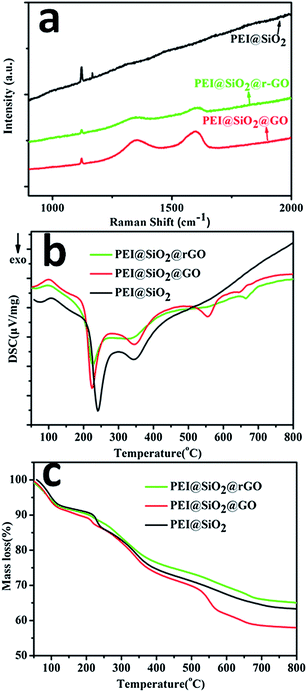 | ||
| Fig. 4 Raman and thermal analysis of products. (a) Raman spectra, (b) DSC curves, and (c) TG curves of PEI@SiO2, PEI@SiO2@GO, and PEI@SiO2@rGO. | ||
The XPS analysis results are presented in Fig. 5. The C1s spectra of PEI@SiO2@GO and PEI@SiO2@rGO could be interpreted as several carbon atoms in different functional groups: 284.8 eV for non-oxygenated C, 285.9 eV for C–N, 286.8 eV for C–O, 287.9 eV for C![[double bond, length as m-dash]](https://www.rsc.org/images/entities/char_e001.gif) O, and 289.0 eV for O–C
O, and 289.0 eV for O–C![[double bond, length as m-dash]](https://www.rsc.org/images/entities/char_e001.gif) O (Fig. 5a and b).12 Compared with PEI@SiO2@GO, the peak intensity of the same oxygen functionality in PEI@SiO2@rGO decreased, which indicates the occurrence of de-oxygenation after heating and is in agreement with the FTIR results. Generally, the FTIR spectra for these three samples were quite similar (Fig. 6). For example, peaks at approximately 790, 950, 1034 cm−1 were attributed to the bending vibrations of SiO–H, stretching vibrations of Si–OH, and stretching vibrations of Si–O–Si, respectively. However, in the range between 1300 and 2000 cm−1 (Fig. 6b), some differences were observed. Some weak peaks at 1700–1730 cm−1 in the PEI@SiO2@GO spectrum were assigned to the C
O (Fig. 5a and b).12 Compared with PEI@SiO2@GO, the peak intensity of the same oxygen functionality in PEI@SiO2@rGO decreased, which indicates the occurrence of de-oxygenation after heating and is in agreement with the FTIR results. Generally, the FTIR spectra for these three samples were quite similar (Fig. 6). For example, peaks at approximately 790, 950, 1034 cm−1 were attributed to the bending vibrations of SiO–H, stretching vibrations of Si–OH, and stretching vibrations of Si–O–Si, respectively. However, in the range between 1300 and 2000 cm−1 (Fig. 6b), some differences were observed. Some weak peaks at 1700–1730 cm−1 in the PEI@SiO2@GO spectrum were assigned to the C![[double bond, length as m-dash]](https://www.rsc.org/images/entities/char_e001.gif) O of GO. Compared with PEI@SiO2 and PEI@SiO2@GO, the peaks for PEI@SiO2@rGO at 1413 (CO–H), 1551(N–H), and 1618(O–H) cm−1 became weaker or even disappeared.17
O of GO. Compared with PEI@SiO2 and PEI@SiO2@GO, the peaks for PEI@SiO2@rGO at 1413 (CO–H), 1551(N–H), and 1618(O–H) cm−1 became weaker or even disappeared.17
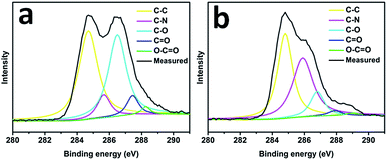 | ||
| Fig. 5 XPS analysis of products. (a) C1s XPS spectra of PEI@SiO2@GO and (b) PEI@SiO2@rGO. (XPS spectra was calibrated using C1s peak located at 284.6 eV as a reference.) | ||
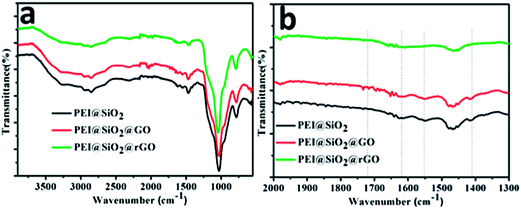 | ||
| Fig. 6 FTIR spectra of products. (a) FTIR spectra of PEI@SiO2, PEI@SiO2@GO, and PEI@SiO2@rGO. (b) Magnified image of FTIR spectra in the range from 1300 to 2000 cm−1. | ||
The FTIR results were helpful in understanding the formation mechanisms of these composites. Based on the high degree of similarity of the FTIR spectra, it was speculated that the chemical reactions between PEI@SiO2 and GO at room temperature was not the main reason for their combination. In this case, electrostatic interactions were the driving force was and were supported by the zeta potential measurement. For the PEI@SiO2@rGO obtained at 90 °C, the weak or absent peaks at 1413 (CO–H), 1551 (N–H), and 1618 (O–H), 1700–1730 (C![[double bond, length as m-dash]](https://www.rsc.org/images/entities/char_e001.gif) O) cm−1 indicated the occurrence of chemical reactions. Generally, carboxyl groups attach to the edge of the 2-D carbon skeleton while epoxy and hydroxyl groups are distributed on the plane. Amino groups could link with carboxyl groups via an amidation process, and GO was thus immobilised onto PEI@SiO2 (seeing Fig. 7). This process was frequently utilised to modify the surface of inorganic components for the following attachment to GO. It is also possible for amino groups to react with epoxy and hydroxyl groups, although we could not distinguish whether these groups changed due to an overlap with the peaks of PEI@SiO2 in the range of 1000–1250 cm−1 in the FT-IR. After being heated to 90 °C, the colour changed to black, as shown in Fig. 2, which revealed the reduction of GO on PEI@SiO2. However, due to the complexity of chemical reduction of GO into rGO, the reduction mechanisms are mostly proposed, and only a few papers involve the description based on molecular computation.6,17 As for the reduction of GO by PEI@SiO2, a possible mechanism is proposed as follows (Fig. 7). PEI could be introduced onto GO by interaction with epoxy and/or carboxyl groups. For the epoxy, after its ring opening attacked by PEI, the as-formed OH groups may interact with adjacent amine groups, followed by the removal of H2O and C–N bond from GO and formation of C
O) cm−1 indicated the occurrence of chemical reactions. Generally, carboxyl groups attach to the edge of the 2-D carbon skeleton while epoxy and hydroxyl groups are distributed on the plane. Amino groups could link with carboxyl groups via an amidation process, and GO was thus immobilised onto PEI@SiO2 (seeing Fig. 7). This process was frequently utilised to modify the surface of inorganic components for the following attachment to GO. It is also possible for amino groups to react with epoxy and hydroxyl groups, although we could not distinguish whether these groups changed due to an overlap with the peaks of PEI@SiO2 in the range of 1000–1250 cm−1 in the FT-IR. After being heated to 90 °C, the colour changed to black, as shown in Fig. 2, which revealed the reduction of GO on PEI@SiO2. However, due to the complexity of chemical reduction of GO into rGO, the reduction mechanisms are mostly proposed, and only a few papers involve the description based on molecular computation.6,17 As for the reduction of GO by PEI@SiO2, a possible mechanism is proposed as follows (Fig. 7). PEI could be introduced onto GO by interaction with epoxy and/or carboxyl groups. For the epoxy, after its ring opening attacked by PEI, the as-formed OH groups may interact with adjacent amine groups, followed by the removal of H2O and C–N bond from GO and formation of C![[double bond, length as m-dash]](https://www.rsc.org/images/entities/char_e001.gif) C bonds, which may be promoted by the spatial polyamine environment and GO skeleton. Still, this mechanism needs to be probed further through additional experiments.
C bonds, which may be promoted by the spatial polyamine environment and GO skeleton. Still, this mechanism needs to be probed further through additional experiments.
Additionally, we also introduced a common reductant KBH4 for GO reduction at 90 °C. Compared with PEI@SiO2, the colour of the reactant solution and product after addition of KBH4 was similar (Fig. S1a and S1b†). Meanwhile, similar cases were found in the thermal decomposition behaviours in terms of mass loss and thermal decomposition temperatures of the final products with and without addition of KBH4 (Fig. S1c and S1d†). These results also indicate that PEI possesses the reducing ability to GO. Based on the above results, we believe that PEI@SiO2 and GO were connected with each other at room temperature without the additional surface modification of either SiO2 or GO. GO could have been reduced into rGO at an increased temperature in the presence of PEI in PEI@SiO2 hybrids without additional reducing agents. However, since GO can be easily adsorbed onto PEI@SiO2, it should be pointed out that some unreduced GO may be remained on the PEI@SiO2@rGO because the centrifugation could not separate completely unreduced GO and rGO.
It is possible that the existence of oxygen-containing groups renders GO hydrophilic and accessible to metal ions by means of electrostatic forces or cation–π complexation. In contrast, the decrease of oxygen-containing groups make rGO more hydrophobic and can increase its affinity for aromatic compounds through π–π stacking.29–34 These characteristics will allow such composites to be used for applications such as dye removal and water purification by taking advantage of the properties of GO and rGO. The disposal of a large amount of toxic heavy metal ions and organic dyes has led to severe world-wide water pollution, and the removal or degradation of these species is urgently needed. This study shows that PEI@SiO2@GO is a high-efficiency absorbent for the removal of heavy metal ions of Hg2+ and PEI@SiO2@rGO for organic dyes (RhB, MB). It was found that the obtained PEI@SiO2@GO showed the removal efficiency for Hg2+ was approximately 96%. Usually the concentration of Hg2+ in contaminated water ranges from 0.05 ppm to 10 ppm,35 so the high efficiency for Hg2+ makes the product a good absorbent for Hg2+. However, it was noted that PEI@SiO2 also showed a relatively high removal efficiency of 84% for Hg2+, which indicates that both GO and PEI@SiO2 contribute to the adsorption of Hg2+. In terms of PEI@SiO2, the individual contribution from PEI or SiO2 is difficult to evaluate because of its hybrids state. In our opinion, the absorption of Hg2+ is attributed to the interaction (e.g., electrostatic forces, cation–π complexation) between Hg2+ and amino groups in PEI and/or oxygen functionalities. Nevertheless, the increased removal efficiency of PEI@SiO2@GO demonstrated that GO grafted onto PEI@SiO2. For PEI@SiO2@rGO, the removal efficiency for RhB and MB reached 81% and 67% (Fig. 8a and b, calculated using the spectra intensity change), respectively, after 10 min, and increased to 85% and 77% after 30 min, indicating a good removal efficiency for these two types of dyes. To further identify which components are responsible for the dyes removal, the efficiencies at given time of PEI@SiO2, PEI@SiO2@GO, and PEI@SiO2@rGO are compared. For RhB adsorption, the corresponding efficiency is 28% (60 min, Fig. S2a†), 48% (30 min), and 85% (30 min), respectively. Therefore, rGO possesses better RhB adsorption performance than GO while the adsorption ability of PEI@SiO2 is not negligible. For MB adsorption, the corresponding efficiency is 2% (60 min, Fig. S2b†), 68% (30 min), and 77% (30 min), respectively. As a result, the MB adsorption is mainly attributed to GO and/or rGO and the contributions from PEI@SiO2 seem to be not obvious. However, because the separation unreduced GO and rGO is difficult, the specific adsorption effect of GO or rGO is not clear yet. From these results, although GO shows a lower RhB removal efficiency than rGO, but their MB adsorption performances are comparable. According to the analysis above, we think that both GO and PEI play an important role in the adsorption of Hg2+. Generally, both GO and rGO increase the adsorption of dyes, and the enhance effect caused by rGO is especially significant compared with PEI@SiO2. For RhB adsorption, rGO shows an obviously improved ability than GO; while, for MB adsorption, the efficiency of GO seemed lower than but close to that of rGO.
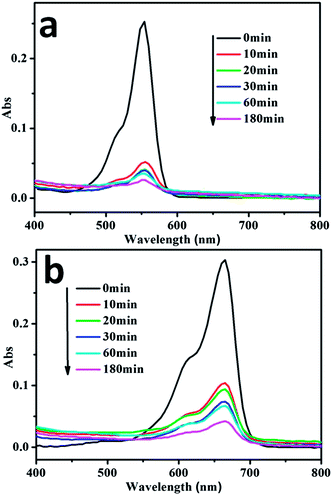 | ||
| Fig. 8 Absorption ability of products for organic dyes. The time-dependent absorption spectra of (a) RhB and (b) MB solution after being mixed with PEI@SiO2@rGO. | ||
Conclusion
In conclusion, we have demonstrated that PEI@SiO2 can interact with GO due to the existence of PEI embedded in SiO2. The cationic nature of PEI, which intercalated the SiO2 framework and created a positively charged surface on the SiO2, also enabled the PEI to reduce GO into rGO. During the formation of SiO2 on the pre-formed PEI templates, PEI was embedded into SiO2 with some PEI molecular protruding the SiO2 framework, which endowed novel surface properties of SiO2. To some degree, the as-formed PEI@SiO2 can be considered as a PEI-modified SiO2. Therefore, without the additional surface modification of SiO2 and additional reductants, GO or rGO could be easily absorbed onto SiO2 by simple mixing. Depending upon the reaction temperature, GO or rGO could be selectively produced. The PEI@SiO2@GO showed good absorption ability for Hg2+ and PEI@SiO2@rGO for RhB and MB dyes. The concept of PEI based synergistic process of integrating nanostructured silica and reduced GO can be extended to the other inorganic nanomaterials systems such as TiO2, GeO2, Ag for different applications.Acknowledgements
This study was supported in part by funds from MOST (2009CB939904, 2012AA030305, 2012BAA10B03) and NSFC (Contract no: 51172265).References
- A. K. Geim and K. S. Novoselov, Nat. Mater., 2007, 6, 183–191 CrossRef CAS PubMed.
- K. S. Novoselov, V. I. Fal'ko, L. Colombo, P. R. Gellert, M. G. Schwab and K. Kim, Nature, 2012, 490, 192–200 CrossRef CAS PubMed.
- M. J. Allen, V. C. Tung and R. B. Kaner, Chem. Rev., 2010, 110, 132–145 CrossRef CAS PubMed.
- W. S. Hummers and R. E. Offeman, J. Am. Chem. Soc., 1958, 80, 1339–1339 CrossRef CAS.
- D. R. Dreyer, S. Park, C. W. Bielawski and R. S. Ruoff, Chem. Soc. Rev., 2010, 39, 228–240 RSC.
- S. F. Pei and H. M. Cheng, Carbon, 2012, 50, 3210–3228 CrossRef CAS PubMed.
- K. P. Loh, Q. Bao, G. Eda and M. Chhowalla, Nat. Chem., 2010, 2, 1015–1024 CrossRef CAS PubMed.
- O. C. Compton and S. T. Nguyen, Small, 2010, 6, 711–723 CrossRef CAS PubMed.
- S. Guo and S. Dong, Chem. Soc. Rev., 2011, 40, 2644–2672 RSC.
- S. Bai and X. Shen, RSC Adv., 2012, 2, 64–98 RSC.
- X. Huang, X. Qi, F. Boey and H. Zhang, Chem. Soc. Rev., 2012, 41, 666–686 RSC.
- Q. Liu, J. Shi, J. Sun, W. Thanh, L. Zeng and G. Jiang, Angew. Chem., Int. Ed., 2011, 50, 5913–5917 CrossRef CAS PubMed.
- S. Yang, X. Feng, S. Ivanovici and K. Muellen, Angew. Chem., Int. Ed., 2010, 49, 8408–8411 CrossRef CAS PubMed.
- W. Zhou, J. Zhu, C. Cheng, J. Liu, H. Yang, C. Cong, C. Guan, X. Jia, H. J. Fan, Q. Yan, C. M. Li and T. Yu, Energy Environ. Sci., 2011, 4, 4954–4961 CAS.
- L. Chen, S. Chai, K. Liu, N. Ning, J. Gao, Q. Liu, F. Chen and Q. Fu, ACS Appl. Mater. Interfaces, 2012, 4, 4398–4404 CAS.
- J.-W. Liu, Q. Zhang, X.-W. Chen and J.-H. Wang, Chem.–Eur. J., 2011, 17, 4864–4870 CrossRef CAS PubMed.
- J. Che, L. Shen and Y. Xiao, J. Mater. Chem., 2010, 20, 1722–1727 RSC.
- Y. Chen, X. Zhang, P. Yu and Y. Ma, Chem. Commun., 2009, 4527–4529 RSC.
- M. Sumper and E. Brunner, ChemBioChem, 2008, 9, 1187–1194 CrossRef CAS PubMed.
- G. Pohnert, Angew. Chem., Int. Ed., 2002, 41, 3167–3169 CrossRef CAS.
- N. Kroger, R. Deutzmann and M. Sumper, Science, 1999, 286, 1129–1132 CrossRef CAS.
- S. V. Patwardhan, Chem. Commun., 2011, 47, 7567–7582 RSC.
- N. Kroeger and K. H. Sandhage, MRS Bull., 2010, 35, 122–126 CrossRef.
- N. Nassif and J. Livage, Chem. Soc. Rev., 2011, 40, 849–859 RSC.
- R. H. Jin and J. J. Yuan, Chem. Commun., 2005, 1399–1401 RSC.
- R.-H. Jin and J.-J. Yuan, Adv. Mater., 2009, 21, 3750–3753 CrossRef CAS.
- R.-H. Jin and J.-J. Yuan, in Advances in Biomimetics, (Ed. A. George), Intech, 2011, Ch.8, pp 159–184 Search PubMed.
- X.-L. Liu, P.-X. Zhu, Y.-F. Gao and R.-H. Jin, Materials, 2012, 5, 1787–1799 CrossRef CAS.
- W. Gao, M. Majumder, L. B. Alemany, T. N. Narayanan, M. A. Ibarra, B. K. Pradhan and P. M. Ajayan, ACS Appl. Mater. Interfaces, 2011, 3, 1821–1826 CAS.
- G. Zhao, J. Li, X. Ren, C. Chen and X. Wang, Environ. Sci. Technol., 2011, 45, 10454–10462 CrossRef CAS PubMed.
- T. S. Sreeprasad, S. M. Maliyekkal, K. P. Lisha and T. Pradeep, J. Hazard. Mater., 2011, 186, 921–931 CrossRef CAS PubMed.
- V. Chandra and K. S. Kim, Chem. Commun., 2011, 47, 3942–3944 RSC.
- G. Zhao, L. Jiang, Y. He, J. Li, H. Dong, X. Wang and W. Hu, Adv. Mater., 2011, 23, 3959–3963 CrossRef CAS PubMed.
- H. Bi, X. Xie, K. Yin, Y. Zhou, S. Wan, L. He, F. Xu, F. Banhart, L. Sun and R. S. Ruoff, Adv. Funct. Mater., 2012, 22, 4421–4425 CrossRef CAS.
- A. Sinha and N. R. Jana, Chem. Commun., 2012, 48, 9272–9274 RSC.
Footnote |
| † Electronic supplementary information (ESI) available. See DOI: 10.1039/c3ra46733c |
| This journal is © The Royal Society of Chemistry 2014 |

